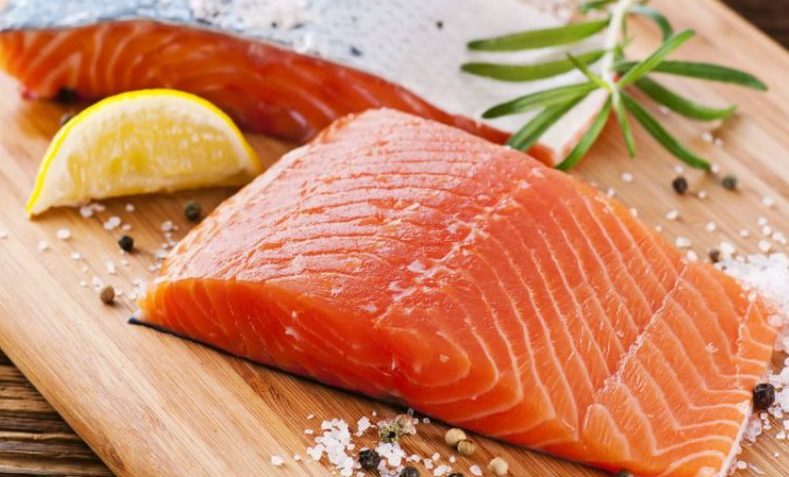What is Salmon
Salmon has a flavorful flesh and is rich in heart-beneficial omega-3 oils. Salmon tops the list of most healthful foods. It is high in protein and A and B complex vitamins. Salmon is a meaty and oily fish so it lends itself to a big variety of cooking techniques such as poaching, steaming, baking, grilling, boiling and pan-frying. It is used fresh or canned. Smoked Salmon is a delicacy that never fades out of fashion. Salmon is also farmed but the farmed product has a blander flavor and softer texture. You may purchase Salmon fresh, frozen, smoked, and canned.
How to Store Salmon
You can keep Salmon in the refrigerator. Salmon can be kept for up to two days in the refrigerator. To do that you should rinse the Salmon thoroughly with cold water and pat dry with a paper towel. Wrap the fish tightly in a layer of plastic wrap and then in a layer of aluminum foil. Before you wrap it up you can also add lemon slices for taste. Place the wrapped fish in the coldest part of your refrigerator, most likely the bottom drawer. Temperature in your fridge should be around 32 degrees Fahrenheit.
You can put Salmon in the freezer. Move the Salmon to the freezer if you are not planning to consume it within two days. Salmon can be fresh for up to three months if you freeze it. To store Salmon in the freezer, follow the same storing steps as for refrigeration but take extra care in ensuring the Salmon is packaged air-tight in plastic and foil wrap. Otherwise it will spoil. Don’t forget to label the date on the Salmon package to keep track of how long its been freezing. If the Salmon is vacuum-sealed you can freeze it for up to eight months.
How do you know if Salmon is fresh?
Fresh Salmon has a vibrant pink color and it looks shiny. As fresh Salmon smells mildly like ocean, a somewhat “fishy” smell tells you that it may be spoiled. The flesh of a fresh Salmon is firm and it will spring back when pressed.
Nutrients in Salmon
Salmon is considered a super food because it is highly rich in vitamins, minerals and beneficial oils known as essential fatty acids.
[content padding=”0px 5px 0px 5px”]Salmon Nutrition Facts[/content]
[column md=”8″]
Serving Size[/column][column md=”4″]
1/2 fillet (4 oz or 124 g)[/column] [content padding=”0px 5px 0px 5px”][column md=”8″]
Per Serving[/column][column md=”4″]
% Daily Value*[/column][/content] [column md=”8″]
Calories[/column][column md=”4″]
185[/column] [column md=”8″]
Calories from Fat[/column][column md=”4″]
49[/column] [column md=”8″]Total Fat 5.5g[/column][column md=”4″]8%[/column] [column md=”8″]Saturated Fat 0.9g[/column][column md=”4″]4%[/column] [column md=”8″]Polyunsaturated Fat[/column][column md=”4″]2.1g[/column] [column md=”8″]Monounsaturated Fat[/column][column md=”4″]1.5g[/column] [column md=”8″]
Cholesterol 83mg[/column][column md=”4″]
28%[/column] [column md=”8″]
Sodium 107mg[/column][column md=”4″]
4%[/column] [column md=”8″]
Potassium 513.36mg[/column][column md=”4″]
15%[/column] [column md=”8″]
Carbohydrates 0g[/column][column md=”4″]
0%[/column] [column md=”8″]Dietary Fiber 0g[/column][column md=”4″]0%[/column] [column md=”8″]
Sugars[/column][column md=”4″]
0g[/column] [column md=”8″]
Protein[/column][column md=”4″]
31.7g[/column] [column md=”8″]Vitamin A[/column][column md=”4″]3%[/column] [column md=”8″]Vitamin C[/column][column md=”4″]0%[/column] [column md=”8″]Calcium[/column][column md=”4″]2%[/column] [column md=”8″]Iron[/column][column md=”4″]7%[/column] *Based on a 2,000 calorie diet
How to Prepare Salmon
- Remove the skin from the salmon, if you prefer it skinless.
- If there are bones in the fish, remove them.
- Season the salmon by sprinkling salt and pepper on both sides of it. You may also add other herbs such as parsley, dill, tarragon, and garlic.
- Coat the salmon with olive oil or white wine, and add any other flavors you like such as brown sugar, lemon or butter.
How to Cook Salmon
You may cook Salmon in many ways unlike most fish that require a certain cooking method. You will get great results when you bake, barbecue, poach, steam or grill Salmon.
Click here for the most delicious salmon recipes.
